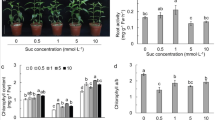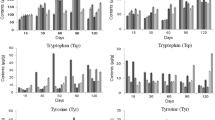Abstract
Shikimate pathway leads to the production of several secondary metabolites including caffeic acid derivatives (CADs), phenols and flavonoids and its regulation is assumed to respond to the requirements for both the synthesis of protein and secondary metabolites. We tested the response of growth, accumulation of phenols, flavonoids, caffeic acid, CADs profiles and activities of shikimate dehydrogenase (SKDH; EC. 1.1.1.25), chorismate mutase (CM; EC. 5.4.99.5), phenylalanine ammonia lyase (PAL; EC. 4.3.1.5) to glyphosate-induced starvation and feeding of aromatic amino acids (l-phenylalanine and l-tryptophan) in adventitious root cultures of Echinacea purpurea. Feeding of l-phenylalanine enhanced the growth but the accumulation of phenols, flavanoids and caffeic acid was lower in comparison to the l-tryptophan fed cultures. The addition of l-tryptophan (0.5, 1 and 5 mM) resulted in an increase up to 56, 61, 84 % in phenol, 24, 12, 3 % in flavonoids and 86, 63, 39 % in total caffeic acid. When glyphosate was added, the growth and accumulation of secondary metabolites were suppressed massively. The addition of l-tryptophan to the media not only countered the deleterious impact of glyphosate but enhanced the growth and accumulation of secondary metabolites in root cultures. The activity of SKDH, CM and PAL induced in presence of l-tryptophan. However, l-phenylalanine addition resulted in increase and decrease of PAL and CM activity, respectively. The presence of glyphosate maximally induced the PAL activity but that could not be translated into higher accumulation of secondary metabolites as it suppresses the accumulation of its substrates i.e. aromatic amino acids. Among CADs, highest cichoric acid and chlorogenic acid was found in l-tryptophan (0.5 mM) which was 2.0 and 1.62 times more than the control treatments. We concluded that addition of l-tryptophan (indolic pathway precursor) and not the l-phenylalanine (phenylpropanoid pathway precursor) stimulate the growth and accumulation of secondary metabolites in adventitious root cultures of E. purpurea (L.) Moench.






Similar content being viewed by others
References
Abbasi BH, Tian C, Murch SJ, Saxena PK, Liu C (2007) Light-enhanced caffeic acid derivatives biosynthesis in hairy root cultures of Echinacea purpurea. Plant Cell Rep 26:1367–1372
Abbasi BH, Stiles AR, Saxena PK, Liu C-Z (2012) Gibberellic acid increases secondary metabolite production in Echinacea purpurea hairy roots. Appl Biochem Biotechnol 168:2057–2066
Akashi T, Ishizaki M, Aoki T, Ayabe S (2005) Isoflavonoid production by adventitious root cultures of Iris germanica (Iridaceae). Plant Biotechnol 22:207–215
Amrhein N, Deus B, Gehrke P, Steinrucken HC (1980) The site of the inhibition of the shikimate pathway by glyphosate II. Interference of glyphosate with chorismate formation in vivo and in vitro. Plant Physiol 66:830–834
Bauer R (1998) Echinacea: biological effects and active principals. Phytomedicines of Europe. In: Lawson LD, Bauer R (eds) Chemistry and biological activity. ACS Symposium Series 691 American Chemical Society, Washington, pp 140–157
Cheminat A, Zawatzky R, Becker H, Brouillard R (1988) Caffeoyl conjugates from Echinacea species: structures and biological activity. Phytochemistry 27:2787–2794
Choi O, Wu C-Z, Kang SY, Ahn JS, Uhm T-B, Hong Y-S (2011) Biosynthesis of plant-speciWc phenylpropanoids by construction of an artificial biosynthetic pathway in Escherichia coli. J Ind Microbiol Biotechnol 38:1657–1665
Cui L, Wang ZY, Zhou XH (2012) Optimization of elicitors and precursors to enhance valtrate production in adventitious roots of Valeriana amurensis Smir. ex Kom. Plant Cell Tissue Organ Cult 108:411–420
D’Cunha GB, Satyanarayan V, Nair PM (1996) Purification of phenylalanine ammonia-lyase from Rhodotorula glutinis. Phytochemistry 42:17–20
Diaz J, Barcelo AR, De Caceres FM (1997) Changes in shikimate dehydrogenase and the end products of the shikimate pathway, chlorogenic acid and lignins, during the early development of seedlings of Capsicum annuum. New Phytol 136:183–188
Ding L, Hofius D, Hajirezaei MR, Fernie AR, Bornke F, Sonnewald U (2007) Functional analysis of the essential bifunctional tobacco enzyme 3-dehydroquinate dehydratase/shikimate dehydrogenase in transgenic tobacco plants. J Exp Bot 58:2053–2067
Edhahiro J-I, Nakamura M, Seki M, Furusaki S (2005) Enhanced accumulation of anthocyanin in cultured strawberry cells by repetitive feeding of l-phenylalanine into the medium. J Biosci Bioeng 99:43–47
Facino RM, Carini M, Aldini G, Marinello C, Arlandini E, Franzo L, Colombo M, Pietta P, Mauri P (1993) Direct characterization of caffeoyl esters with antihyaluronidase activity in crude extracts from Echinacea angustifolia roots by fast atom bombardment tandem mass spectrometry. Farmaco 48:1447–1456
Facino RM, Carini M, Aldini G, Saibene L, Pietta P, Mauri P (1995) Echinacoside and caffeoyl conjugates protect collagen from free radical-induced degradation: a potential use of Echinacea extracts in the prevention of skin photodamage. Planta Med 61:510–514
Fett-Neto AG, Melanson SJ, Sakata K, DiCosmo F (1993) Improved growth and taxol yield in developing callus of Taxus cuspidata by medium composition modification. Biotech 11:731–734
Fett-Neto AG, Melanson SJ, Nicholson SA, Pennington JJ, DiCosmo F (1994) Improved taxol yield by aromatic carboxylic and amino acid feeding to cell cultures of Taxus cuspidata. Biotechnol Bioeng 44:967–971
Folin O, Ciocalteu V (1927) On tyrosine and tryptophane determination in proteins. J Biol Chem 27:627–650
Goers SK, Jensen RA (1984) Separation and characterization of two chorismate-mutase isoenzymes from Nicotiana silvestris. Planta 162:109–116
Guyer D, Patton D, Ward E (1995) Evidence for cross-pathway regulation of metabolic gene-expression in plants. Proc Natl Acad Sci USA 92:4997–5000
Herrmann KM (1995) The shikimate pathway as an entry to aromatic secondary metabolism. Plant Physiol 107:7–12
Ibrahim RK (1987) Regulation of synthesis of phenolics. In: Constabel F, Vasil I (eds) Cell culture and somatic cell genetics of plants. Academic Press, San Diego, vol 4, pp 77–95
Johal GS, Rahe JE (1988) Glyphosate, hypersensitivity and phytoalexin accumulation in the incompatible bean anthracnose host-parasite interaction. Physiol Mol Plant Pathol 32:267–281
Karppinen K, Hokkanen J, Tolonen A, Maltila S, Hohtola A (2007) Biosynthesis of hyperforin and adhyperforin from amino acid precursors in shoot cultures of Hypericum perforatum. Phytochemistry 68:1038–1045
King PJ, Ma G, Miao W, Jia Q, McDougall BR, Reinecke MG, Cornell C, Kuan J, Kim TR, Robinson WE (1999) Structure– activity relationships: analogues of the dicaffeoylquinic and dicaffeoyltartaric acids as potent inhibitors of human immunodeficiency virus type 1 integrase and replication. J Med Chem 42:497–509
Kiong LP, Mahmood M, Fadzillah NM, Daud SK (2005) Effects of precursor supplementation on the production of triterpenes by Centella asiatica callus cultures. Pak J Biol Sci 8:1160–1169
Leonard E, Koffas MA (2007) Engineering of artificial plant cytochrome P450 enzymes for synthesis of isoflavones by Escherichia coli. Appl Environ Microbiol 73:7246–7251
Lin Z, Neamati N, Zhao H, Kiryu Y, Turpin JA, Aberham C, Strebel K, Kohn K, Wityrouw M, Pannecouque C, Debyser Z, De Clercq E, Rice WG, Pommier Y, Burke RT (1999) Cichoric acid analogues as HIV-1 integrase inhibitors. J Med Chem 42:1401–1414
Lindsey K, Yeoman MM (1984) The synthetic potential of immobilized cells of Capsicum frutescens Mill. cv. annuum. Planta 162:495–501
Liu XN, Zhang XQ, Zhang SX, Sun JS (2007) Regulation of metabolite production by precursors and elicitors in liquid cultures of Hypericum perforatum. Plant Cell Tissue Organ Cult 91:1–7
Liu R, Li W, Sun LY, Liu CZ (2012) Improving root growth and cichoric acid derivatives production in hairy root culture of Echinacea purpurea by ultrasound treatment. Biochem Eng J 60:62–66
Matsukawa T, Ishihara A, Iwamura H (2002) Differential induction of chorismate mutase isoforms by elicitors in oat leaves. Plant Physiol Biochem 40:795–802
McCue KF, Conn EE (1990) Induction of shikimic acid pathway enzymes by light in suspension cultured cells of parsley (Petroselinum crispum). Plant Physiol 94:507–510
Min JY, Jung HY, Kang SM, Kim YD, Kang YM, Park DJ, Prasad DT, Choi MS (2007) Production of tropane alkaloids by small-scale bubble column bioreactor cultures of Scopolia parviflora adventitious roots. Bioresour Technol 98:1748–1753
Morgan JA, Shanks JV (2000) Determination of metabolic rate-limitations by precursor feeding in Catharanthus roseus hairy root cultures. J Biotechnol 79:137–145
Mulder-Krieger T, Verpoorte R, Svendse A, Scheffer J (1988) Production of essential oils and flavours in plant cell and tissue cultures: a review. Plant Cell Tissue Organ Cult 13:85–114
Murashige T, Skoog F (1962) A revised medium for rapid growth and bioassays with tobacco tissue cultures. Physiol Plant 15:473–497
Murthy HN, Lee EJ, Paek KY (2014) Production of secondary metabolites from cell and organ cultures: strategies and approaches for biomass improvement and metabolite accumulation. Plant Cell Tissue Organ Cult 118:1–16
Paek KY, Murthy HN, Hahn EJ (2009) Establishment of adventitious root cultures of Echinacea purpurea for the production of caffeic acid derivatives. Methods Mol Biol 547:3–16
Palacio L, Cantero JJ, Cusido R, Goleniowski M (2011) Phenolic compound production by Larrea divaricata Cav. plant cell cultures and effect of precursor feeding. Process Biochem 46:418–422
Pellati F, Benvenuti S, Magro L, Melegari M, Soragni F (2004) Analysis of phenolic compounds and radical scavenging activity of Echinacea spp. J Pharm Biomed Anal 35:289–301
Perassolo M, Quevedo CV, Giuletti AM, Talou JR (2011) Stimulation of the proline cycle and anthraquinone accumulation in Rubia tinctorum cell suspension cultures in the presence of glutamate and two proline analogs. Plant Cell Tissue Organ Cult 106:153–159
Pinto JEBP, Dyer WE, Weller SC, Herrmann KM (1988) Glyphosate induces 3-Deoxy-D-arabino-heptulosonate 7pPhosphate synthase in potato (Solanum tuberosum L.) cells grown in suspension culture. Plant Physiol 87:891–893
Sabra A, Adam L, Daayf F, Renault S (2012) Salinity-induced changes in caffeic acid derivatives, alkamides and ketones in three Echinacea species. Environ Exp Bot 77:234–241
Sakanaka S, Tachibana Y, Okada Y (2005) Preparation and antioxidant properties of extracts of Japanese persimmon leaf tea (kakinoha-cha). Food Chem 89:569–575
Sharon A, Amsellem Z, Gressel J (1992) Glyphosate suppression of an elicited defense response. Plant Physiol 98:654–659
Singh BK, Lonergan SG, Conn EE (1986) Chorismate mutase isoenzymes from selected plants and their immunological comparison with the isoenzymes from Sorghum bicolor. Plant Physiol 81:717–722
Vats S, Kamal R (2014) Cassia occidentalis L. (a new source of rotenoids): its in vitro regulation by feeding precursors and larvicidal efficacy. Plant Cell Tissue Organ Cult 116:403–409
Wielanek M, Urbanek H (2006) Enhanced glucotropaeolin production in hairy root cultures of Tropaeolum majus L. by combining elicitation and precursor feeding. Plant Cell Tissue Organ Cult 86:177–186
Wu CH, Dewir YH, Hahn EJ, Paek KY (2006) Optimization of culturing conditions for the production of biomass and phenolics from adventitious roots of Echinacea angustifolia. J Plant Biol 49:193–199
Wu CH, Murthy HN, Hahn EJ, Paek KY (2007) Large-scale cultivation of adventitious roots of Echinacea purpurea in air-lift bioreactors for the production of chichoric acid, chlorogenic acid and caftaric acid. Biotechnol Lett 29:1179–1182
Xu CG, Tang TX, Chen R, Liang CH, Liu XY, Wu CL, Yang Y-S, Yang D-P, Wu H (2014) A comparative study of bioactive secondary metabolite production in diploid and tetraploid Echinacea purpurea (L.) Moench. Plant Cell Tissue Organ Cult 116:323–332
Zenk MH (1991) Chasing the enzymes of secondary metabolism: plant cultures as a pot of gold. Phytochemistry 30:3861–3863
Acknowledgments
This work is financially supported by the Ministry of Education and Human Resources Development (MOE), the Ministry of Commerce, Industry and Energy (MOCIE) and the Ministry of Labor (MOLAB) through the fostering project of the Lab. of Excellency, Korea.
Author information
Authors and Affiliations
Corresponding author
Rights and permissions
About this article
Cite this article
Mobin, M., Wu, CH., Tewari, R.K. et al. Studies on the glyphosate-induced amino acid starvation and addition of precursors on caffeic acid accumulation and profiles in adventitious roots of Echinacea purpurea (L.) Moench. Plant Cell Tiss Organ Cult 120, 291–301 (2015). https://doi.org/10.1007/s11240-014-0606-1
Received:
Accepted:
Published:
Issue Date:
DOI: https://doi.org/10.1007/s11240-014-0606-1




